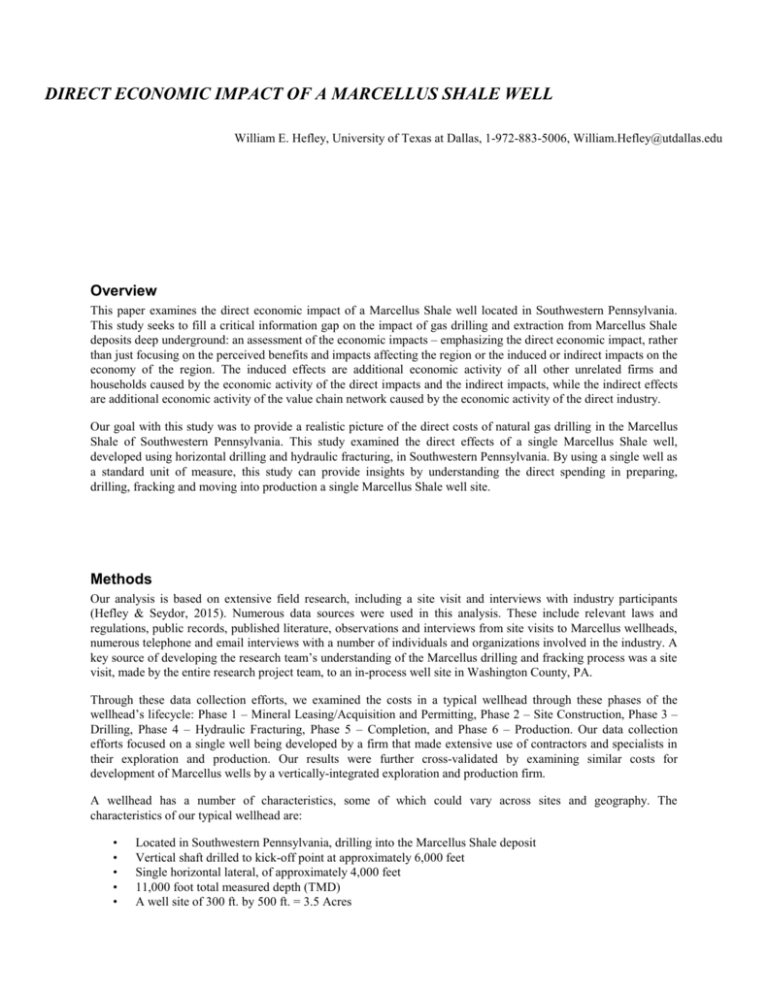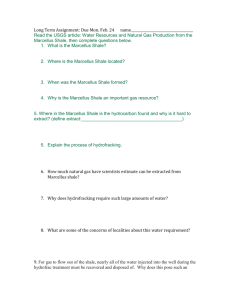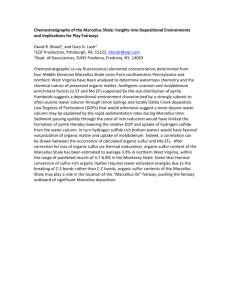View Extended Abstract
advertisement

DIRECT ECONOMIC IMPACT OF A MARCELLUS SHALE WELL William E. Hefley, University of Texas at Dallas, 1-972-883-5006, William.Hefley@utdallas.edu Overview This paper examines the direct economic impact of a Marcellus Shale well located in Southwestern Pennsylvania. This study seeks to fill a critical information gap on the impact of gas drilling and extraction from Marcellus Shale deposits deep underground: an assessment of the economic impacts – emphasizing the direct economic impact, rather than just focusing on the perceived benefits and impacts affecting the region or the induced or indirect impacts on the economy of the region. The induced effects are additional economic activity of all other unrelated firms and households caused by the economic activity of the direct impacts and the indirect impacts, while the indirect effects are additional economic activity of the value chain network caused by the economic activity of the direct industry. Our goal with this study was to provide a realistic picture of the direct costs of natural gas drilling in the Marcellus Shale of Southwestern Pennsylvania. This study examined the direct effects of a single Marcellus Shale well, developed using horizontal drilling and hydraulic fracturing, in Southwestern Pennsylvania. By using a single well as a standard unit of measure, this study can provide insights by understanding the direct spending in preparing, drilling, fracking and moving into production a single Marcellus Shale well site. Methods Our analysis is based on extensive field research, including a site visit and interviews with industry participants (Hefley & Seydor, 2015). Numerous data sources were used in this analysis. These include relevant laws and regulations, public records, published literature, observations and interviews from site visits to Marcellus wellheads, numerous telephone and email interviews with a number of individuals and organizations involved in the industry. A key source of developing the research team’s understanding of the Marcellus drilling and fracking process was a site visit, made by the entire research project team, to an in-process well site in Washington County, PA. Through these data collection efforts, we examined the costs in a typical wellhead through these phases of the wellhead’s lifecycle: Phase 1 – Mineral Leasing/Acquisition and Permitting, Phase 2 – Site Construction, Phase 3 – Drilling, Phase 4 – Hydraulic Fracturing, Phase 5 – Completion, and Phase 6 – Production. Our data collection efforts focused on a single well being developed by a firm that made extensive use of contractors and specialists in their exploration and production. Our results were further cross-validated by examining similar costs for development of Marcellus wells by a vertically-integrated exploration and production firm. A wellhead has a number of characteristics, some of which could vary across sites and geography. The characteristics of our typical wellhead are: • • • • • Located in Southwestern Pennsylvania, drilling into the Marcellus Shale deposit Vertical shaft drilled to kick-off point at approximately 6,000 feet Single horizontal lateral, of approximately 4,000 feet 11,000 foot total measured depth (TMD) A well site of 300 ft. by 500 ft. = 3.5 Acres These assumed characteristics allowed us to develop a cost model of a typical wellhead, and are reflected in the value chain, which describe each phase of the lifecycle and the direct economic impact of each phase of the Marcellus Shale extraction lifecycle. Results The analyses yielded a view of the direct costs of natural gas extraction from the Marcellus Shale, in terms of examining the direct economic impact of a single Marcellus Shale horizontal well site. Table 1 shows the estimated total costs by lifecycle phase of a typical Marcellus Shale well. In summary, as the direct costs alone are significant, the development of a Marcellus Shale well is likely to have considerable economic impact on the region. The central costs in development are: site preparation and reclamation (nearly 2/5ths of total cost), mobilization of equipment and materials, including drilling rigs and hydraulic fracking equipment, power generation throughout the process, and steel and steel derivatives. Table 1 – Estimated total direct costs of a Marcellus Shale well Feature Description ACQUISITION & LEASING PERMITTING SITE PREPARATION VERTICAL DRILLING HORIZONTAL DRILLING FRACTURING COMPLETION PRODUCTION TO GATHERING Total Cost $2,191,125 $10,075 $400,000 $663,275 $1,214,850 $2,500,000 $200,000 $472,500 $7,651,825 Conclusions From this field research, we determined that the direct costs of bringing a Marcellus Shale well to production is in excess of 7 million dollars. The economic benefits are significant - both direct, which this study addressed, as well as indirect and induced economic benefits, which have been addressed by other studies (Wang, 2015). References Hefley, W. & Seydor, S. (2015). Direct Economic Impact of the Value Chain of a Marcellus Shale Gas Well, Chapter 2 in Hefley, W. & Wang, Y. (eds.), Economics of Unconventional Shale Gas Development - Case Studies and Impacts. Springer, pp. 15-45. Wang, Y. & Stares, D. (2015). Analysis of the Shale Gas Economy in Washington County, Pennsylvania, Chapter 3 in Hefley, W. & Wang, Y. (eds.), Economics of Unconventional Shale Gas Development - Case Studies and Impacts. Springer, pp. 47-69.






